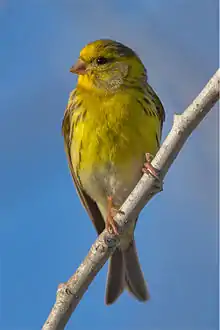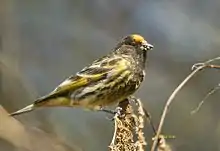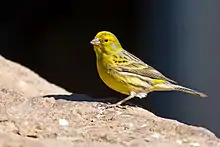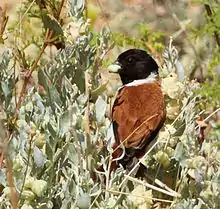Serinus
Serinus is a genus of small birds in the finch family Fringillidae found in Europe and Africa. The birds usually have some yellow in their plumage. The genus was introduced in 1816 by the German naturalist Carl Ludwig Koch.[1][2] Its name is New Latin for "canary-yellow".[3]
| Serinus | |
|---|---|
 | |
| Male European serin (Serinus serinus) | |
| Scientific classification | |
| Kingdom: | Animalia |
| Phylum: | Chordata |
| Class: | Aves |
| Order: | Passeriformes |
| Family: | Fringillidae |
| Subfamily: | Carduelinae |
| Genus: | Serinus Koch, 1816 |
| Species | |
|
See text. | |
Many species were at one time assigned to the genus but it became clear from phylogenetic studies of mitochondrial and nuclear DNA sequences that the genus was polyphyletic.[4][5][6] This was confirmed by Dario Zuccon and coworkers in a comprehensive study of the finch family published in 2012. The authors suggested splitting the genus into two monophyletic groups, a proposal that was accepted by the International Ornithologists' Union. The genus Serinus was restricted to the European serin and seven other species while a larger clade from Africa and Arabia was assigned to the resurrected genus Crithagra.[7][8]
The genus contains eight species:[8]
| Image | Scientific name | Common Name | Distribution |
|---|---|---|---|
 | Serinus pusillus | Red-fronted serin | Turkey and Iran |
_010.jpg.webp) | Serinus serinus | European serin | southern and central Europe and North Africa |
| Serinus syriacus | Syrian serin | Syria, Lebanon, Israel and Jordan | |
 | Serinus canaria | Atlantic canary | the Canary Islands, the Azores, and Madeira |
.jpg.webp) | Serinus canicollis | Cape canary | southern Africa |
.jpg.webp) | Serinus flavivertex | Yellow-crowned canary | eastern Africa |
 | Serinus nigriceps | Ethiopian siskin | Ethiopia |
 | Serinus alario | Black-headed canary | Lesotho, Namibia and South Africa |
References
- Koch, Carl Ludwig (1816). System der baierischen Zoologie, Volume 1 (in German). Nürnberg. p. 228.
- Paynter, Raymond A. Jnr., ed. (1968). Check-list of birds of the world, Volume 14. Cambridge, Massachusetts: Museum of Comparative Zoology. p. 208.
- Jobling, James A. (2010). The Helm Dictionary of Scientific Bird Names. London, United Kingdom: Christopher Helm. p. 354. ISBN 978-1-4081-2501-4.
- Arnaiz-Villena, A.; Alvarez-Tejado, M.; Ruiz-del-Valle, V.; García-de-la-Torre, C.; Varela, P.; Recio, M.; Ferre, S.; Martinez-Laso, J. (1999). "Rapid Radiation of Canaries (Genus Serinus)" (PDF). Molecular Biology and Evolution. 16 (1): 2–11. doi:10.1093/oxfordjournals.molbev.a026034.
- Ryan, P.G.; Wright, D.; Oatley, G.; Wakeling, J.; Cohen, C.; Nowell, T.L.; Bowie, R.C.K.; Ward, V.; Crowe, T.M. (2004). "Systematics of Serinus canaries and the status of Cape and Yellow-crowned Canaries inferred from mtDNA and morphology". Ostrich. 75 (4): 288–294. doi:10.2989/00306520409485457. S2CID 84396955.
- Nguembock, B.; Fjeldså, J.; Couloux, A.; Pasquet, E. (2009). "Molecular phylogeny of Carduelinae (Aves, Passeriformes, Fringillidae) proves polyphyletic origin of the genera Serinus and Carduelis and suggests redefined generic limits". Molecular Phylogenetics and Evolution. 51 (2): 169–181. doi:10.1016/j.ympev.2008.10.022. PMID 19027082.
- Zuccon, Dario; Prŷs-Jones, Robert; Rasmussen, Pamela C.; Ericson, Per G.P. (2012). "The phylogenetic relationships and generic limits of finches (Fringillidae)" (PDF). Molecular Phylogenetics and Evolution. 62 (2): 581–596. doi:10.1016/j.ympev.2011.10.002. PMID 22023825.
- Gill, Frank; Donsker, David (eds.). "Finches, euphonias". World Bird List Version 5.2. International Ornithologists' Union. Retrieved 5 June 2015.
External links
| Wikimedia Commons has media related to Serinus canaria. |
- Serin videos, photos and sounds on the Internet Bird Collection